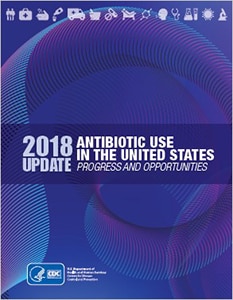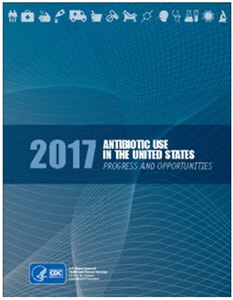Antibiotic Prescribing and Use in the U.S.
CDC is working to promote appropriate antibiotic use by helping prescribers use the right antibiotic, at the right dose, for the right duration, and at the right time, and reduce unnecessary antibiotic use.
Improving the way we prescribe and use antibiotics, or “antibiotic stewardship,” is critical to effectively treat infections, protect patients from harms caused by unnecessary antibiotic use, and combat antibiotic resistance. The United States has made some progress in improving antibiotic prescribing and use in human health, but many opportunities remain.
NEW Antibiotic Use in the United States, 2018 Update: Progress and Opportunities
This 2018 update highlights new antibiotic stewardship data, programs, and resources since the July 2017 report. CDC continues to work to improve antibiotic prescribing and use through data for action, implementation, innovation, and education.
Antibiotic Use in the United States, 2017: Progress and Opportunities
Outpatient Settings:
Nationally, antibiotic prescribing in outpatient settings like clinics, doctor’s offices, and emergency rooms decreased by five percent from 2011 to 2014, but variations among age groups and geographic locations point to areas where prescribing can be improved. CDC estimates that 30 percent of all antibiotics prescribed in outpatient clinics are unnecessary. Even when antibiotics are needed, prescribers often favor drugs that may be less effective and carry more risk over more targeted first-line drugs recommended by national guidelines.
Nursing Homes:
More data are needed to understand antibiotic use in nursing homes, where approximately four million Americans receive care each year. A small CDC study of nine nursing homes showed that 11 percent of nursing home residents were taking antibiotics on any single day, and nearly 40 percent of orders for antibiotics lacked important prescribing information. CDC is launching a larger study with more nursing homes across the country and pursuing partnerships with nursing home networks, pharmacies, and other companies to identify where action is needed most.
Hospitals:
Hospital antibiotic use data point to opportunities to improve prescribing practices. For example, use of the most powerful antibiotics increased significantly from 2006 to 2012, by nearly 40 percent for carbapenems and more than 30 percent for vancomycin. Data also indicate that roughly 30 percent of antibiotics used in hospitals are unnecessary or prescribed incorrectly.
























.png)











No hay comentarios:
Publicar un comentario